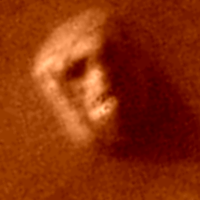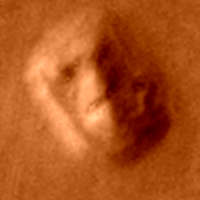 |
|
The Face on Mars
The Face
|
|
|
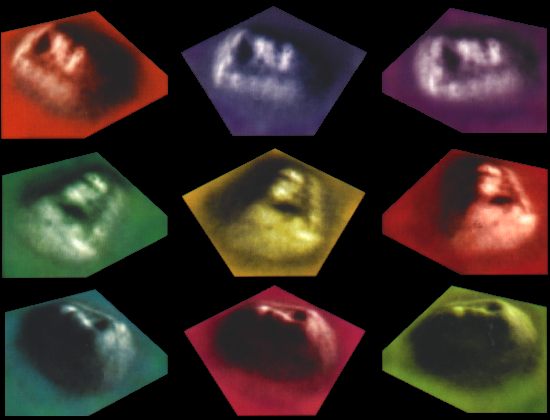
Three dimensional renderings by Mark J. Carlotto, PhD
Interpolated from his famous Shape From Shading technique
which analyzed the original Viking photos in 256 color grayscale
and determines a pixel's altitude in relation to the ones surrounding it
very much like we are able to tell the shape of an object with one eye closed.
Images from the cover of "The Case for the Face" ~ edited by McDaniel and Paxson.
|
|
|
|
Staredown
What one piece of substantial evidence would possibly cause people to believe that life, Human life, was once thriving on the planet Mars?
Of all the amazing things discovered in the 20th century this one chance find could prove to be the pinnacle turning point in our modern history.
But NASA officials and the media at large dismiss the Face - easily poking fun at the many, once esteemed, scientists who dare to analyze it.
And analyze it, they have - but what they've found goes against everything our society is founded on.
Most Cydonia investigators have put their careers on the line, and even their health in jeopardy,
searching for a truth too possible to ignore - and too important to write off as fantasy.
Even admitting their arguments are well based, that the inescapable conclusions may possibly have some merit,
and that the whole subject warrants further investigation, can put a colleague in the column of dissent.
Thus, many do not - and, the sham goes on.
A veil of secrecy also remains around the recent controversial redating of the Sphinx
- and thus, likely the entire Giza complex, pyramids and all, putting its construction at approximately 10,500 BC.
This date figures in with pre-existing Atlantis "myths" and the Great Flood of Noah's Ark as well.
Thus, Cydonia has since become a landmark find for serious Atlantis theorists,
as it further lends support to their theories of Man being much older than our history allows.
|
|
|
|
|
The main reason why people usually can't subscribe wholeheartedly to the Face being a real artifact is their struggle with the implications.
What it means is: that there was life on Mars long ago, Humanoid life, and probably our distant ancestors - thus, our entire view of history must be rewritten.
But many of our current institutions, from government to religion, have a stake in the status quo - hence the controversy.
Most scientists are not on the cutting edge of research, just regular people doing their jobs.
Dedicated and sincere though they may be - as a group, they're not particularly excited about any fascinating new discoveries or paradigm shifts, thank you.
Besides, anything extremely off the beaten track, that also contradicts their research: if proven, could leave them quickly out of a job.
Another reason why guessing wrong early can leave a species perpetually planetbound - the inability to go where the science leads.
If the Face were an aerial shot of some place on Earth, no one would have any problem with it.
Teams of scientists would immediately be dispatched to the site to determine its origins - and many believe that this is in fact what has happened.
But even if black project technologies are not yet advanced enough for this to have occurred as yet, this is most assuredly why it's being kept a secret.
In fact, once we finally get to Mars, as a settling force, these sites will likely be strictly off limits to all unauthorized personnel.
It is a certainty that Viking I saw what it did, in two different images, on two different sunny days - one in the mid afternoon, the other closer to early evening.
But even if it is an optical illusion, or as they say, "a trick of light and shadow," imagine flying over the Face as a tourist or settler a hundred years from now.
The skies over Cydonia might be very crowded on sunny afternoons,
if that turns out to be the only time of day when a Face can be made out from the contours of the mound.
Until then, Carlotto's colorful 3D renderings (below), taken from the cover of The Case for the Face, may have to do.
|
|
|
|
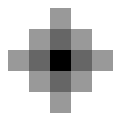
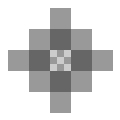
|
|
The Face of Truth
The object in question is approximately 2.5 kilometers long, one kilometer wide, and 400 meters high.
That translates to roughly a mile and a half long, just over half a mile wide, and a quarter mile high.
Of equal megalithic proportion, in the immediate vicinity of the Face, are many other curious structures of similar size and interesting arrangement.
So, one might easily say: that absolute proof of Human existence outside of Earth's protective atmosphere has been leaked to the public from NASA archives.
But, until manned missions are sent to the Cydonia region Mars, and possibly even after, there will always be skeptics to say that it's just a bizarre coincidence.
In the meantime, all we have to go by are a handful of satellite images - the enhanced versions hotly disputed my mainstream science.
While the images are enhanced, they are not fake.
In image processing terms, "enhanced" means: to bring out more detail not easily seen in the original image.
The human eye can see about 32 shades of gray, while the raw binary data from Viking was four times more accurate, at 128.
This higher number is especially helpful in image processing, when more detail becomes visually clear by simply increasing the contrast in 256 grayscale.
|
|
|
|
The first step in the Shape From Shading technique, developed and utilized by Carlotto, is to convert the raw data into pixels.
Bear in mind that each pixel covers an area about 50 meters across (over 160 feet), a total of 250 square meters.
In order to bring out details smaller than this, Pixel Replication replicates each pixel, thereby making the image larger,
- although some "appropriate" contrast is applied, it does not yet increase the effective resolution.
The next step is Pixel Interpolation, which applies an algorithm to the data to determine the slope,
and therefore the physical shape of the substance recorded by the imager
- in effect, "a statistical analysis of the data provided by the pixel relationships"
which is often able to derive "unseen" values and thereby recover the original shape of the subject of the photograph.
There are various types of techniques, using different algorithms, taking into account different groupings of adjacent pixels
- each with unique characteristics and success rates when applied to known objects.
These techniques are otherwise widely accepted as credible, and are basically just "reverse engineering" the way the camera gathers its data in the first place.
The Starburst Pixel Interleaving Technique (SPIT) was developed by NASA scientists and Viking frame "rediscoverers" Vincent DiPietro and Gregory Molenaar,
and takes a total of twelve surrounding pixels into account while converting each pixel into nine of more accurate detail, and thereby tripling the resolution.
Image enhancement and extrapolation techniques of this sort, and more advanced,
are used extensively today by security and intelligence agencies, and even the entertainment industry,
for anything from clearing up static, to satellite photography, to (ironically) facial recognition.
Even in "the face" of supposed ridicule for validating observations that the Face on Mars is an artificial artifact,
the science is not being put to question (after all, our world has been made brighter and clearer because of it).
The only thing that people seem to be bothered by is the inescapable conclusion that there is something intelligently constructed on the surface of Mars.
|
|
|
|
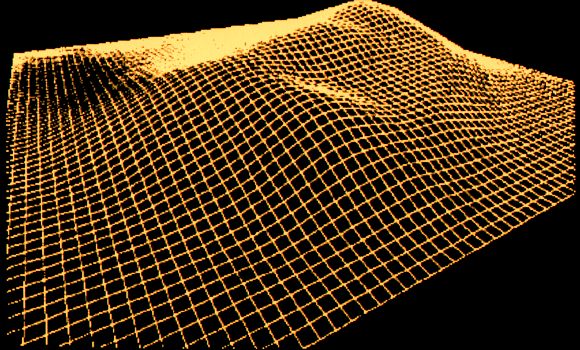
"Isometric plot of the 3D reconstruction obtained using the single image
Shape From Shading algorithm on NASA Viking frame 70A13.
A similar result was obtained for frame 35A72."
~ Dr. Brian O'Leary, space scientist
|
|
|
More Than Meets the Eye
Upon further investigation of the original Viking frames and later enhanced images,
other more "subliminal" features eventually presented themselves to several squinting researchers, working independently.
Not all of these curiosities showed prominence in the high resolution MGS photos released by NASA in 1998, however
- and all are summarily dismissed as merely products of enhanced noise, somehow coincidentally in both original Viking images.
Closer looks at the Face revealed several interesting and seemingly contextual artifacts: such as a Pupil, Teeth, a Teardrop (above right),
the very noticeable parallel Stripes or Notches at the side of the helmet (below left).
and especially exciting center symmetrical cross-hatched etchings at the top of the helmet (below right).
The outer shape of the Face mound is a symmetrical oval with flattened sides, possessing further symmetry and apparent contextual overall design.
In addition, these further details, painting a more detailed portrait,
do tend rule out chance erosion as a likely cause for the increasingly improbable shape of the mound.
The Pupil did in fact turn out to be a grouping of very dark pixels in the original data;
but the Teardrop (above right), is shown to be an actual surface feature in recent photos (inset below) - a molehill upon a mountain, of sorts.
Roughly the size of an average suburban dwelling, it too stands out from the general area, being by far the most prominent object in its local area.
The Teeth remain even more a subject of controversy
- but the feature is shown in modern images to be a ridge parallel to the Lips marking the top and bottom of the Mouth area.
Contextual references will apparently have to be authenticated by manned archaeological missions.
In this case, beauty is in the eye of the beholder.
Prominent Crossed Lines over the eyes, on the Helmet's top (left), also refused to vanish upon closer, more modern inspection;
and strengthen the initial impression that the Helmet appears reminiscent of a Pharaonic head-dress,
as seen throughout ancient Egyptian art, the theme of which also being associated with giant pyramids.
Perhaps another outlandish if controversial connection is to the many depictions of Ancient Astronauts from various cultures worldwide
- only realized as these obvious depictions in modern times, after the invention of space suits.
The side Notches, or Stripes (right), are also shown to be valid geological features in the MGS images, although perhaps somewhat less prominent than expected.
Perhaps it is fortunate that Viking flew over and photographed Cydonia, twice
- and both at just the time of day when the Face would be most apparent
- otherwise we may not know about this ancient, fascinating and likely archaeological site.
Who knows how many other sites like this exist on the planet Mars, showing signs of ancient Human occupation, that we simply haven't found out about yet?
Some, like Elysium (also seen to have the almost requisite giant pyramidal shaped mounds), are being looked into
- but none so far are as intriguing as the region surrounding the Face.
|
|
|
|
|
Head of the Class
In 1996, a small group of students at North Kelvenside Secondary School in Glasgow, Scotland undertook an independent investigation of the Cydonia anomalies
- and got a Martian mound, the NK Pyramid, named after them in the process.
Chris O'Kane, an audio visual technician at the school and the award winning developer of the Vistamorph panoramic photography system,
along with computer science department head Mike Turner, acquired extensive original image data from NSSDC, Viking I orbits 3 thru 70
- and recruited prominent Mars anomaly investigators Stanley McDaniel, Ananda Sirsena and Erol Torun to serve as scientific advisers for the project.
Working on ordinary PCs, that by today's standards can be considered quite primitive,
they were easily able to discern further details of the Cydonia Complex, and focused their attention on several anomalies.
One of the first things that they noticed, when examining the 22,000 square mile area,
was that the other objects of Cydonia became more noticeable
when the image was tilted so that the Face could be viewed right side up.
While this could be an "artifact" of the shading provided by the afternoon sun in both images,
it could also have been an intended effect in the site's construction.
|
|
|
|
|
Just as faces lose their familiarity when tilted,
it seems the architects Cydonia
applied this quality of the eye
and designed the layout of the complex
to be appreciated from a certain perspective, with north as up.
The Face itself was discovered to be extremely eroded, or damaged, on the eastern (shaded) side - as if by the very disaster that transformed the entire planet.
The five sided D&M Pyramid was also examined closely, and observed to be symmetrically pointing north towards the Face, and to also have a damaged eastern facet.
A number of other anomalies were investigated, all of which are now being given closer attention by Cydonia investigators.
That spring, they presented their conclusions at the Edinburgh International Science Festival,
which was warmly received by both the audience and the national media,
whose coverage was described by O'Kane as being "on the whole accurate and responsible."
In an email to Dr. Michael Malin, of Malin Space Science Systems and in charge of Mars Global Surveyor imaging,
they requested that the newly christened NK pyramid be imaged in the upcoming mapping mission.
Malin wrote in his reply to the group that:
"we cannot expect to 'hit' any specific target on Mars. Rather we hope to acquire representative images of many areas, including Cydonia."
This was taken by many as being politely dismissive
- and it was clear that the findings for the group were not being taken openly seriously by any official source.
|
|
|
|
|
From: The Case for the Face, p. 77 - "A Picture's Worth" by Chris O'Kane
|
|
The students concluded that the face is not symmetrical but that the left [east] side is collapsed, eroded or damaged
and does not closely resemble the right [west] side.
The Face does however have clear symmetrical markings in the form of lines on the forehead.....
A dark circular feature next to the eastern side of the structure is very unusual in that it does not resemble any other crater in the region which was studied.
It seems to be a deep, dark hole which the sunlight does not illuminate.
We could see the bottom of all craters in this region but we could not see the bottom of this feature.
It was also noted that the axis of symmetry of the D&M Pyramid points north to intersect the Face.
|
|
|
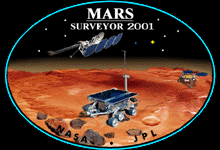
|
|
Saving Face
When we went to Mars this time around, NASA was supposedly looking for something that we already knew was there.
Despite the lack of seriousness surrounding their official position, NASA has, on the surface, been making every "reasonable" effort to photograph Cydonia.
The only problem is, their data appears to be altered to more reflect their view on the subject
- which is, and has always been, that the anomalies could not possible be artificial in nature and that "most scientists" consider it to be merely an optical illusion.
In a somewhat successful attempt to diffuse the mounting public fervor surrounding the Face on Mars,
just one week before a new book by Cydonia investigative scientists entitled The Case for the Face was released,
this "faceless" Mars Global Surveyor photo (above) was widely released by NASA on April 5, 1998.
Mars Global Surveyor flew over the Cydonia site one sunny Martian morning and snapped this much clearer picture for us patient Earthlings.
NASA promised they would pay special attention to images gathered of the region, and it seems on the surface as if they did.
A national press release was issued that politely poked fun at the monument, asking: "does this look like a face to you?"
- but accompanying the snide text were pictures that are out of contrast, and make the Martian mound resemble a disaster area.
|
|
|
|
This is an unusual image, in that it was shot not from overhead, but at a 45� angle
- and in the bright lighting of the early morning sun, instead of the afternoon sunlight and long shadows of the original Viking images.
With the only available high resolution images of the Face being lit from the southeast, easily obscuring many details,
NASA has again come under suspicion of trying to hide the truth from Face investigators.
Although undoubtedly given many opportunities to photograph the site at multiple camera angles and at different angles of the sun,
a modern high resolution westerly perspective afternoon picture of the Face has yet to be forthcoming.
The 98 MGS image actually does look like it used to be a face, but somehow suffered incredible damage
- almost as if the evidence were conveniently destroyed.
Some conspiracy theorists charge that the mound was bombed by clandestine probes, or even black project astronauts stationed on Mars.
To be fair, top secret projects involving manned missions in space would explain much about the Mars issue, and beyond.
But other research has confirmed that the east side of the Face appeared damaged in the original Viking photos,
which is curiously consistent with other Cydonian monuments
- and also with what we know, and can surmise, of ancient Martian global catastrophes.
In any case, the Face in the new image does appear significantly different from that in the original Viking photos, despite being the most conspicuous object in the region.
NASA is using this as simple proof of their calm claim: that the Face is nothing more than "a trick of light and shadow"
- thereby dismissing the entire region from public attention.
Even if it never was a Face, the right angles incorporated in the object are still inconsistent with the rest of the surroundings
- and still by far the most unnatural object by fractal analysis, moreso than most terrestrial man-made artifacts photographed from space.
The investigation continues, armed with more accurate observations of the Cydonia complex
- and in fact, the entire region.
|
|
|
|
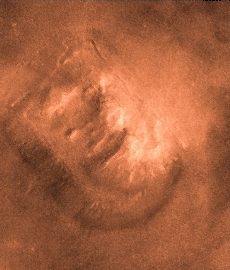 |
 |
High resolution images of the Face, made from the original 1998 MGS image.
False orange color added for contrast (left), and inverted to simulate lighting from the northwest (right).
Click here to see the
larger original full-size, black and white version (72K, opens in new window).
|
|
|
|
|
...a realization of new operational constraints imposed by the new mapping scheme, has caused two sequencing errors over the last week.
On 00-048 (2/17/2000) at about 00:00 UTC, the new Beta Supplement sequence, mm014b, was scheduled to kickoff but never went active.
Since that new sequence controls the tracking of the HGA to Earth, no downlink was possible....
The net effect of the anomaly was the loss of most of DOY 48 recorded science telemetry.
|
|
|
|
Symmetry
It's still symmetrical. It still has parallel sides and symmetrically rounded opposite ends.
It's still aligned to other curious geometrical objects in the immediate vicinity.
It's still a monument centered upon a beveled platform - and it still looks like a face.
|
|
|
|
|
The Face on Mars is not a natural formation.
It may be hard to tell for sure whether or not it was, in fact, a human face;
but whoever made it
knew well about what ancient cultures on Earth called Sacred Geometry
- and they had the means to leave such a lasting impression on such a large outcrop.
But no sign of its repair after the cataclysm that swept across the Red Planet
and probably destroyed most of its ecosphere, making it the frozen desert it is today.
|
|
|
|
|










